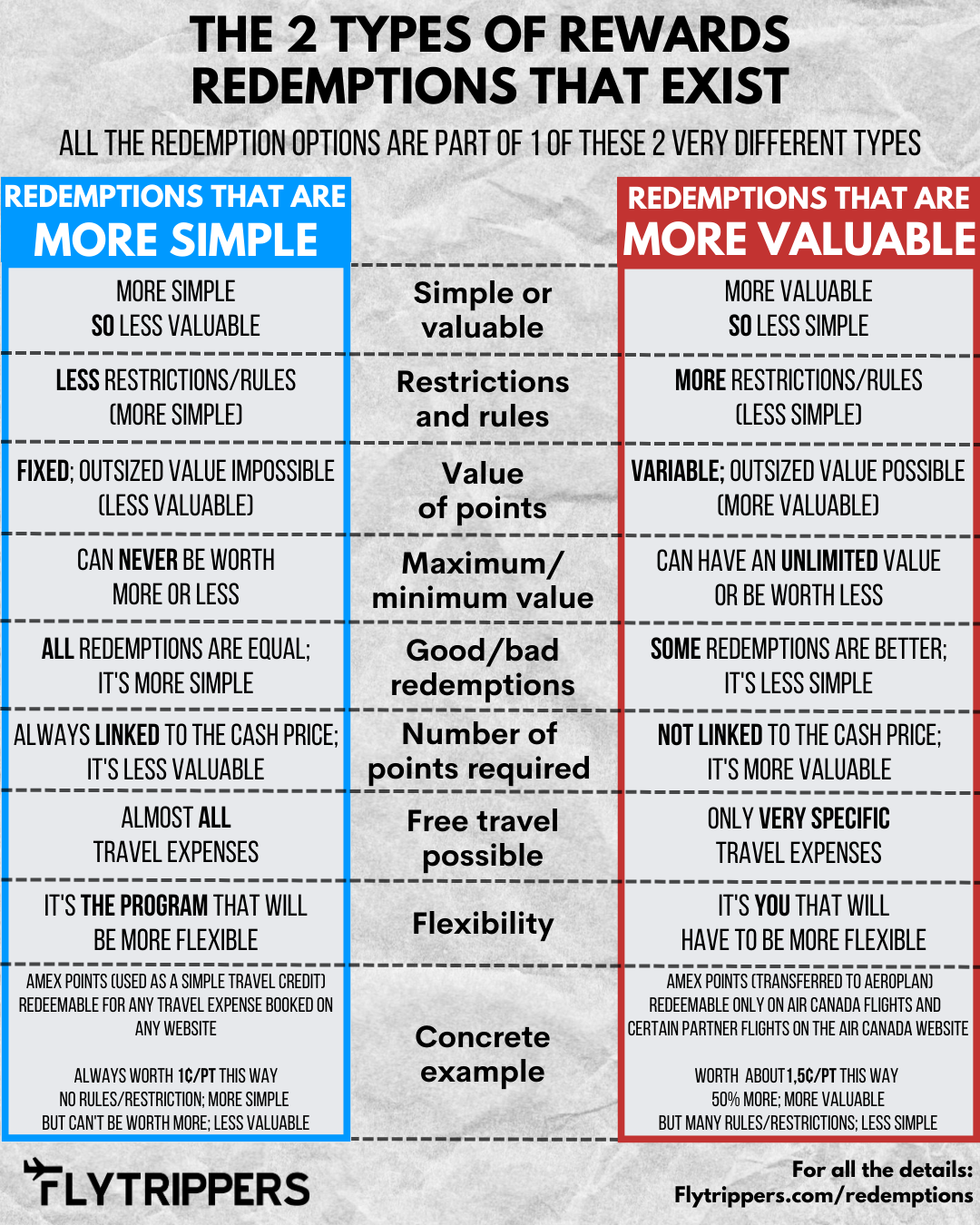Since earning a lot of rewards is so easy, it’s redeeming the rewards that seems to generate a lot of questions. The thing is that there are several options for rewards redemptions (sometimes called uses; redeeming rewards is sometimes called burning rewards), but they all fall into just 2 types — and they are VERY different.
Our free webinar on the basics, a must, is this Wednesday by the way, in case you don’t know the basics of the earning side (which is almost certain unless you’ve already attended).
For the redeeming side, we’ve already shared with you a reminder of how to see the possible redemptions for each rewards program (those sections are going to be improved soon).
And we will have even more details on this aspect in the next update (with even more examples), but today I’m giving you a good and important intro: this revamped vital basics post, to understand well the 2 types of rewards redemptions that exist. With a video and an infographic too.
(Among the many new contents we will have for you soon — Flytrippers’ travel rewards team is finally expanding — many are precisely to help you understand and maximize the redemption side of rewards!)
Video on the 2 types of rewards redemptions
We’ll also be doing more video content for those who prefer this format, so here’s a quick intro to the 2 types of reward redemptions.
View this post on Instagram
Overview of the 2 types of rewards redemptions options
Here is an overview of the basics.
The 2 types of redemptions
There are 2 types of rewards redemptions that exist:
- Redemptions that are more SIMPLE
- Redemptions that are more VALUABLE
They are very different from each other.
The simple/valuable axis is really the main difference between the 2 types of redemptions:
- Redemptions that are more SIMPLE
- More simple
- Because the possible redemptions are less restrictive
- You can redeem for almost any travel
- Less valuable
- Because the value of the points is fixed
- They can never be worth more
- More simple
- Redemptions that are more VALUABLE
- More valuable
- Because the value of the points is variable
- They can provide outsized value
- Less simple
- Because the possible redemptions are more restrictive
- You can redeem for specific travel only
- More valuable
Everything in life is always either more simple or more valuable. Always. It’s the same with travel of course. So it’s our brand new way of properly explaining the key differences in the 2 types of reward redemptions.
(“Valuable” means that it gives you more value in the case of points… and value is simply the amount you save with your points! “Valuable” just means more affordable or less expensive for everything else that is not related to points!)
So if you want to keep it simple, always get only cards with simple points like the TD First Class Travel Visa Infinite Card (literally the highest offer ever in Canada for simple points; ends May 28). You’ll still get plenty of free travel!
But if you like good deals and want to save even more, look into the more valuable rewards too! But I would get the TD First Class Travel Visa Infinite Card right now (I got it myself last week actually) because its record-high deal is so good, because it’s always handy to have simple points too, and because the key is to always get the best deals regularly!
Concrete examples of the 2 types
Here are 2 concrete examples to understand before I give you more details (I use American Express Membership Rewards points, often abbreviated “Amex points”, for the example of each type of redemptions, since they are by far the best points overall):
- Redemptions that are more SIMPLE (Amex points used as a travel credit)
- More simpler, but less valuable
- LESS RESTRICTIVE (it’s the points that are more flexible)
- Can be redeemed for any travel expense
- Can be redeemed on any booking site
- There are no rules or restrictions
- FIXED value points (it does not depend on the redemption chosen)
- Will always be worth 1¢ per point this way
- Can never be worth more
- Can never be worth less
- Redemptions that are more VALUABLE (Amex points transferred to Aeroplan)
- More valuable, but less simple
- MORE RESTRICTIVE (it’s you who needs to be more flexible)
- Can be used on Air Canada flights or certain partner flights
- Can be used on the Air Canada website only
- There are many rules and restrictions
- VARIABLE value points (it depends on the redemption chosen)
- Will be worth about 1.5¢ per point this way
- May be worth 3 times more (4.5¢ per point)
- May be worth less too (1.1¢ per point)
As you can see, for the exact same points currency, the more valuable redemptions are worth easily 50% more! That’s the difference between traveling sadly just 2 times a year and traveling 3 times a year!
Without even earning more points (very easy too), but just by redeeming the same amount of points differently! That’s pretty significant!
Other important details about the 2 types
It’s also very important to understand this:
- There are several very different options for redemptions
- These 2 examples are just 2 of dozens
- Each redemption option has its own details based on the program
- They can all be classified into these 2 types of redemptions
- They are also classified in 11 specific subtypes to help you
- A single rewards program offers several options
- Within the same program
- Including options in both types of redemptions
- Each redemption option works separately
- Each redemption option must be looked at separately
- Each program is unique and different
- For example, Amex points allow all 11 redemption subtypes
- It’s the same 2 types no matter who owns the program
- Airline
- Hotel chain
- Bank/Retailer/Other
Finally, our new naming to explain the 2 types of redemptions will be gradually deployed throughout our content (based on your feedback*).
But we will often abbreviate to make it shorter:
- Simple points
- Points that do not have more valuable redemption options
- Have only more simple redemption options
- Valuable points
- Points that have more valuable redemption options
- Almost always also have more simple redemption options
*It’s brand new so if you have any questions after reading this, now is the time to ask them in the comments at the end of this article — you can even do it anonymously. We want your feedback, we always try to make everything as simple as humanly possible!
Detailed comparison of the 2 types
I obviously give you a lot more details and more concrete examples in the following sections, but I want to summarize the main differences with an infographic of the 2 types of redemptions.

Here is the text version, by component.
Main feature:
- Redemptions that are more SIMPLE
- Therefore less valuable
- Redemptions that are more VALUABLE
- Therefore less simple
Restrictions and rules:
- Redemptions that are more SIMPLE
- Fewer restrictions and rules
- Redemptions that are more VALUABLE
- More restrictions and rules
Value of points:
- Redemptions that are more SIMPLE
- Fixed value
- Redemptions that are more VALUABLE
- Variable value
Maximum value of points:
- Redemptions that are more SIMPLE
- No possibility to get an outsized value and unlimited value
- Redemptions that are more VALUABLE
- Possibility to get an outsized value and unlimited value
Minimum value of points:
- Redemptions that are more SIMPLE
- No risk of getting a lower value
- Redemptions that are more VALUABLE
- Risk of getting a lower value
Good/bad redemptions:
- Redemptions that are more SIMPLE
- The value does not depend on the redemption you choose
- No need to choose the “good” redemptions
- Redemptions that are more VALUABLE
- The value depends on the redemption you choose
- Need to choose the “good” redemptions
Number of points required:
- Redemptions that are more SIMPLE
- Necessarily always linked to the price in cash
- Redemptions that are more VALUABLE
- Not necessarily linked to the price in cash
Free travel possible:
- Redemptions that are more SIMPLE
- Almost any travel expense
- Redemptions that are more VALUABLE
- Specific travel expenses only
Flexibility:
- Redemptions that are more SIMPLE
- It’s the PROGRAM that is going to be more flexible
- Redemptions that are more VALUABLE
- It’s YOU that is going to need to be more flexible
Details of the 2 types of use
So here are the essentials of the 2 types of reward redemptuins, with some concrete examples for each of their subtypes.
In the next update, we’ll have even more examples and details on each of these 11 subtypes of redemptions.
More SIMPLE redemptions
Now you know how the more SIMPLE redemptions work, but more specifically this type of redemption is made up of 4 distinct subtypes. They still share the same characteristics, but the details of the logistics vary a bit.
Here are the 4 subtypes of more SIMPLE redemptions:
- For any trip booked on a specific platform
- For any trip booked anywhere
- For something other than travel (NEVER recommended)
- For cash back or statement credits
Here are some concrete examples to understand the more simple redemptions:
- For any trip booked on a specific platform
- Example: TD Rewards points
- You can redeem them for a flight/hotel/rental car/etc.
- You book on the TD Rewards website
- You redeem your points directly during the purchase
- Points are always worth 0.5¢/pt this way
- The number of points required is linked to the price in cash
- For any trip booked anywhere
- Example: TD Rewards Points
- You can redeem them for a flight/hotel/activities/transport/etc.
- You book on any website
- You redeem your points afterwards to “erase” the expense
- Points are always worth 0.4¢/pt this way
- The number of points required is linked to the price in cash
- For something other than travel (NEVER recommended)
- Example: TD Rewards Points
- You can redeem them for merchandise/gift cards/etc.
- You redeem your points directly during the purchase
- Points are always worth 0.25¢/pt this way
- The number of points required is linked to the price in cash
- For cash back or statement credits
- Example: TD Rewards Points
- You can redeem them to get a credit on your statement
- You redeem your points afterwards to “erase” expenses on your account
- Points are always worth 0.25¢/pt this way
- The number of points required is linked to the price in cash
More VALUABLE redemptions
Now you know how the more VALUABLE redemptions work, but more specifically this type of redemption is made up of 7 distinct subtypes. They still share the same characteristics, but the details of the logistics vary a lot.
Here are the 7 subtypes of more VALUABLE redemptions:
- For reward flights with airlines’ award charts
- For reward flights with airlines’ dynamic pricing
- For reward flights with banks’ award charts
- For reward nights with hotel chains’ award charts
- For reward nights with hotel chains’ dynamic pricing
- For travel expenses different from what the program owner mainly offers
- For something other than travel (NEVER recommended)
Here are some concrete examples to understand the more VALUABLE redemptions:
- For reward flights with airlines’ award charts
- Example: Aeroplan points
- You can redeem them for some flights on partners
- You book on Air Canada’s website
- You redeem your points directly during the purchase
- Points are worth about 1.5¢/pt this way
- The number of points required is set by the award chart (unlimited value)
- For reward flights with airlines’ dynamic pricing
- Example: Aeroplan points
- You can redeem them for any flight on Air Canada
- You book on Air Canada’s website
- You redeem your points directly during the purchase
- Points are worth about 1.1¢/pt this way
- The number of points required is dynamic
- Value not 100% linked to the cash price but also not fixed
- For reward flights with banks’ award charts
- Example: RBC Avion points
- You can redeem them for almost any flight
- You book on the RBC Airline website
- You redeem your points directly during the purchase
- Points are worth about 1.5¢/pt this way
- The number of points required is set by the price table (with a limit)
- For reward nights with hotel chains’ award charts
- Example: World of Hyatt points
- You can redeem them for any room in Hyatt hotels
- You book on the Hyatt website
- You redeem your points directly during the purchase
- Points are worth about 1.7¢/pt this way
- The number of points required is set by the price table (unlimited value)
- For reward nights with hotel chains’ dynamic pricing
- Example: Marriott Bonvoy points
- You can redeem them for any room in Marriott hotels
- You book on Marriott’s website
- You redeem your points directly during the purchase
- The points are worth about 0.9¢/pt this way
- The number of points required is dynamic
- Value not 100% linked to the cash price but also not fixed
- For travel expenses different from what the program owner mainly offers
- Example: Aeroplan points
- You can redeem them for hotels or rental cars or other
- You book on the Air Canada website
- You redeem your points directly during the purchase
- Points are worth about 0.8¢/pt this way
- The number of points required is dynamic
- Value not 100% linked to the cash price but also not fixed
- For something other than travel (NEVER recommended)
- Example: Aeroplan points
- You can redeem them for merchandise/gift cards/etc.
- You buy on Air Canada’s website
- You redeem your points directly during the purchase
- Points are worth about 0.7¢/pt this way
- The number of points required is dynamic
- Value not 100% linked to the cash price but also not fixed
Want to get more content to learn how to earn free travel?
Summary
This introduction to the basics of the 2 types of reward redemptions that exist is vital to understanding how rewards work. It will give you a solid foundation for mastering the different programs, because you should obviously have more than one if you want it to go fast!
What would you like to know about the types of rewards redemptions? Tell us in the comments below.
See the deals we spot: Cheap flights
Explore awesome destinations: Travel inspiration
Learn pro tricks: Travel tips
Discover free travel: Travel rewards
Featured image: Thailand (photo credit: Andrzej Suwara)




